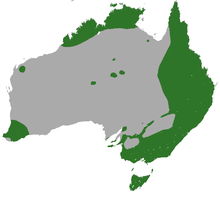Common brushtail possum
| Common brushtail possum | |
|---|---|
 |
|
| Common brushtail possums at Austins Ferry, Tasmania, Australia | |
| Scientific classification | |
| Kingdom: | Animalia |
| Phylum: | Chordata |
| Class: | Mammalia |
| Infraclass: | Marsupialia |
| Order: | Diprotodontia |
| Family: | Phalangeridae |
| Genus: | Trichosurus |
| Species: | T. vulpecula |
| Binomial name | |
|
Trichosurus vulpecula (Kerr, 1792) |
|
| Subspecies | |
|
T. v. vulpecula |
|
 |
|
| Common brushtail possum range | |
T. v. vulpecula
T. v. arnhemensis
T. v. eburacensis
T. v. johnsoni
T. v. fuliginosus
The common brushtail possum (Trichosurus vulpecula, from the Greek for "furry tailed" and the Latin for "little fox", previously in the genus Phalangista) is a nocturnal, semi-arboreal marsupial of the family Phalangeridae, it is native to Australia, and the second largest of the possums.
Like most possums, the common brushtail possum is nocturnal. It is mainly a folivore, but has been known to eat small mammals such as rats. In most Australian habitats, leaves of eucalyptus are a significant part of the diet but rarely the sole item eaten. The tail is prehensile and naked on its lower underside. There are four colour variations: silver-grey, brown, black, and gold.
It is the Australian marsupial most often seen by city-dwellers, as it is one of few that thrives in cities, as well as a wide range of natural and human-modified environments. Around human habitations, common brushtails are inventive and determined foragers with a liking for fruit trees, vegetable gardens, and kitchen raids.
The common brushtail possum was introduced to New Zealand in 1837 to establish a fur industry, but in the mild subtropical climate of New Zealand, and with few to no natural predators, it thrived to the extent that it became a major agricultural and conservation pest.
The common brushtail possum has large and pointed ears. It has a bushy tail (hence its name) that is adapted to grasping branches, prehensile at the end with a hairless ventral patch. Its forefeet have sharp claws and the first toe of each hind foot is clawless but has a strong grasp. The possum grooms itself with the third and fourth toes which are fused together. It has a thick and woolly pelage that varies in colour depending on the subspecies. Colour patterns tend to be silver-gray, brown, black, red or cream. The ventral areas are typically lighter and the tail is usually brown or black. The muzzle is marked with dark patches.
...
Wikipedia

